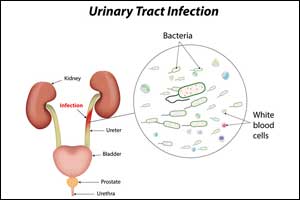- Home
- Editorial
- News
- Practice Guidelines
- Anesthesiology Guidelines
- Cancer Guidelines
- Cardiac Sciences Guidelines
- Critical Care Guidelines
- Dentistry Guidelines
- Dermatology Guidelines
- Diabetes and Endo Guidelines
- Diagnostics Guidelines
- ENT Guidelines
- Featured Practice Guidelines
- Gastroenterology Guidelines
- Geriatrics Guidelines
- Medicine Guidelines
- Nephrology Guidelines
- Neurosciences Guidelines
- Obs and Gynae Guidelines
- Ophthalmology Guidelines
- Orthopaedics Guidelines
- Paediatrics Guidelines
- Psychiatry Guidelines
- Pulmonology Guidelines
- Radiology Guidelines
- Surgery Guidelines
- Urology Guidelines
New Sensor detects hidden urinary tract infection

A new rapid diagnostic assay can detect the traces of cellulose in urine -- the biomarker for biofilm-related urinary tract infection (UTIs), according to a new study published in the journal NPJ Biofilms and Microbiomes.
The study is significant as bacteria such as Escherichia coli tend to hide during infection by encasing themselves in slime. When they grow like this, clusters of bacteria are called a biofilm and they are hard to detect and hard to treat with antibiotics. In this way, they can persist in the urinary tract for prolonged periods of time, evading capture by the immune system and avoiding detection by modern lab methods. Often, they don't cause any discomfort until an infection flares up resulting in periodic and recurrent urinary tract infections.
Also Read: 30 minute antibiotic susceptibility for urinary tract infections
Agneta Richter-Dahlfors, head of the Swedish Medical Nanoscience Center at Karolinska Institutet, and colleagues developed a new way to detect hidden urinary tract infections. The team decided to tackle the problem by looking for the slime that protects the bacteria, instead of the bacteria themselves.
"E. coli that cause urinary tract infections produce a complex protective matrix around themselves comprising largely of cellulose. We developed a chemical sensor that binds to cellulose and produces a measurable output when it is bound," says Richter-Dahlfors.
The important part of this new sensor is that humans naturally do not produce any cellulose so if the sensor lights up there is a high probability that you have an infection. The team wanted to be sure that their sensor would work in the hospital so as soon as they had a proof of concept they quickly moved over into patient samples. The team collected urine samples from Karolinska University Hospital and began testing if their probe would work.
Also Read: Treatment urinary tract infections : Antibiotics better avoided in old patients
"Urine is much more complex than typical laboratory media used to grow bacteria so we had to check if it would work. After some processing, we found that we were able to get a reliable signal in urine from different patients" said Professor Richter-Dahlfors.
The sensor not only alerts medical staff to the presence of bacteria, but it also gives information on how the bacteria are growing which is very important for treatment. Bacteria growing in biofilms are much more resistant to antibiotics and having this information can help determine the correct course of treatment.
" Clinical implementation of this rapid, non-invasive and user-friendly optotracing diagnostic assay will potentially aid clinicians in the design of effective antibiotic treatment," concluded the authors.
For further reference follow the link: https://doi.org/10.1038/s41522-018-0069-y

Disclaimer: This site is primarily intended for healthcare professionals. Any content/information on this website does not replace the advice of medical and/or health professionals and should not be construed as medical/diagnostic advice/endorsement or prescription. Use of this site is subject to our terms of use, privacy policy, advertisement policy. © 2020 Minerva Medical Treatment Pvt Ltd